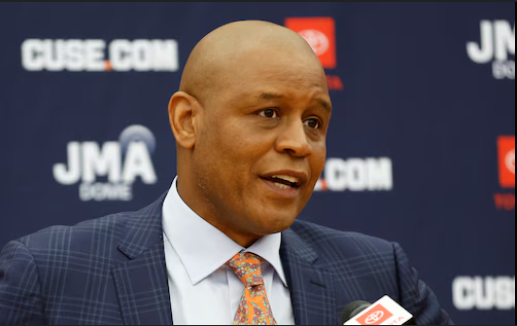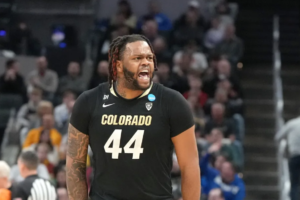
Syracuse men’s basketball: how the transfer portal additions fit with the Orange

During the off-season, Syracuse Orange men’s basketball coach Adrian Autry successfully secured commitments from four players via the transfer portal to counter the departure of seven players from the previous year’s team.
The new additions – Eddie Lampkin Jr. from Colorado, Lucas Taylor from Georgia State, Jyare Davis from Delaware, and Jaquan Carlos from Hofstra – all possess a minimum of three years of collegiate experience, which is expected to be valuable for the Orange. They are anticipated to contribute significantly in supporting both existing and new talents at Syracuse. Their inclusion aims to address certain weaknesses identified from the previous season.
Let’s now analyze the skills that these incoming transfers bring and explore the potential roles they might undertake for the 2024-25 Orange season.
Eddie Lampkin Jr.
In his fifth season in college, Eddie Lampkin Jr., formerly of Colorado, represents one of the most crucial transfer portal acquisitions made by Autry during the off-season.
During the 2023-24 season, Lampkin achieved career-high statistics in points (10.6), rebounds (7.0), assists (2.2), and playing time (27.8 minutes) while serving as the starting center for the Buffaloes, starting in 36 out of 37 games. Prior to his time at Colorado, Lampkin spent three years at TCU, where he gained a reputation as a player who could uplift and ignite his team. Standing at 6’11” and weighing 265 lbs., Lampkin possesses a unique combination of size, strength, and finesse, attributes that Autry will undoubtedly look to leverage to the team’s advantage.
Last year, Syracuse faced challenges with depth and injuries that hindered their competitiveness in the paint. To compensate for deficiencies in defense and rebounding, the team heavily relied on a fast-paced offensive strategy. Lampkin emerges as a crucial figure for Syracuse in the upcoming season, bringing a much-needed sense of stability at the center position, a role that the team often lacked last season.
Lampkin, primarily a traditional center, excels at operating in the post as a scorer and rarely attempts three-point shots throughout his four-year career. Despite his focus on scoring, he has also honed his passing skills, averaging over 2 assists per game. While not known for generating steals (career 0.5 SPG) or blocks (career 0.3 BPG) on the defensive end, his overall size enables him to hold his own effectively.
As discussions about his role within the team arise, key questions surface: 1) Is it assumed that Lampkin will be the starting center? 2) How will he complement five-star forward Donnie Freeman? 3) How will Coach Autry manage Lampkin’s playing time at center in conjunction with Naheem McLeod or potential shifts towards a small-ball lineup?
Lucas Taylor
Coach Autry sought to improve the team’s perimeter shooting and add depth to the scoring options, goals that Lucas Taylor is expected to contribute to.
Following two uneventful seasons at Wake Forest, Taylor’s performance saw significant growth during his single year at Georgia State. He posted a career-best average of 14.5 points while shooting 41%, notably becoming the top scorer for the Panthers last season. Taylor is now set to bring his offensive versatility, both with the ball and without, to help fill the void left by Judah Mintz and Quadir Copeland’s departures at Syracuse.
Taylor’s strength lies in his proficiency with outside shooting. He maintained a three-point shooting percentage of over 35%, attempting nearly six shots per game last season and has a career average of 35% in three-point shooting while averaging 3.6 assists per game. This skill set brings significant value to the Orange. His 181 three-point attempts from the previous season would have positioned him as the second-highest on the team, just behind Chris Bell who had 200 attempts.
The positive outlook for Taylor is that there is potential for increased efficiency overall. While transitioning from Georgia State to the highly competitive ACC presents a significant challenge, he won’t necessarily have the primary responsibility for creating plays at Syracuse. Standing at six-foot-five and weighing 200 lbs., Taylor’s physical attributes make him at least capable of defending other shooting guards.
Jyare Davis
Is it accurate to consider Jyare Davis (averaging 17.1 points, 7.5 rebounds, and 2.4 assists per game in 2023-24) as the most unpredictable factor among the new additions for the upcoming year?
The rationale behind this assessment is the significant departures of Copeland, Justin Taylor, Maliq Brown, and Benny Williams, which resulted in Syracuse essentially losing its entire forward rotation from the previous season, with the exception of Bell. Davis, who brings experience from playing three years at Delaware, is another skilled scorer who excels in creating opportunities for himself, averaging over 15 points per game for two consecutive seasons, particularly through aggressive drives to the basket and scoring predominantly in the paint. Additionally, physically, he possesses the typical attributes of a small forward, a position that was lacking in Syracuse’s lineup the previous year.
Davis has been accustomed to logging more than 33 minutes per game during his tenure with Delaware. His significant contribution to Autry’s lineup is likely to be driven by his prowess in rebounding.
However, the specific role he assumes in the team’s rotation hinges on two primary factors: 1) the shooting proficiency of Syracuse’s guards, which will determine if they can create enough floor spacing for Davis, who has a career three-point shooting percentage of 24.6%, to excel in the interior, and 2) how well he integrates with the other members of Syracuse’s frontcourt, particularly when sharing the court with players like Lampkin or McLeod.
Jaquan Carlos
Similar to Taylor, Jaquan Carlos is anticipated to contribute towards compensating for the offensive output that was diminished during the offseason.
In his role as a consistent starter for Hofstra last season, Carlos achieved career-best statistics in points (10.4), rebounds (4.4), assists (6.3), and steals (1.6). Noteworthy is his progression as a three-point shooter, converting 34.4% of his 3.9 shots per game. Demonstrating versatility on offense, he excels as a playmaker who can effectively score from the outside as well as drive to the basket when necessary.
His integration with Syracuse is poised to offer an intriguing narrative. He stands out as the team’s primary point guard option. Together with Taylor and J.J. Starling, they will predominantly lead the offensive plays, facilitating opportunities for the team and creating favorable scoring chances. Just like Davis, Carlos played substantial minutes at Hofstra last season (averaging 35.5 MPG, with over 32 MPG consistently over the last few years).
Is he expected to be the starting point guard? It’s a possibility. However, Carlos’ adaptable skill set ensures that whether he starts or comes off the bench as the first guard, he will play a crucial role in maintaining stability in Syracuse’s point guard performance.

Leave a Reply